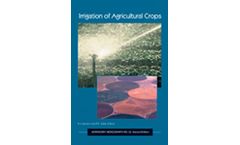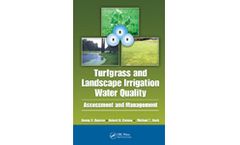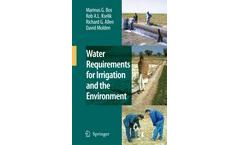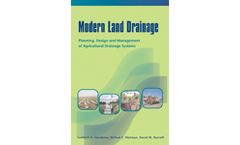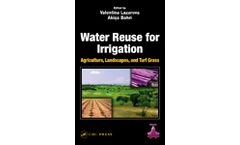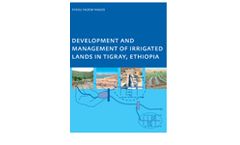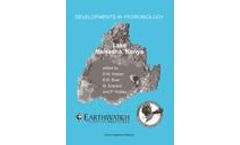Refine by
irrigation books
38 books found
The book covers the essentials of plant nutrition and irrigation management. Throughout the 232 pages of the book, the author, Guy Sela, shares his knowledge on the most important aspects of crop nutrition and irrigation, including: Plant nutrients, fertilizer management practices, interpretation of soil analysis, irrigation water quality, ...
ByCropaia
Management, Performance, and Applications of Micro Irrigation Systems, the fourth volume in the Research Advances in Sustainable Micro Irrigation series, emphasizes sustainable and meaningful methods of irrigation to counter rampant water scarcity. ...
Irrigation is one of the most important human activities sustaining civilization. On average, irrigated crop yields are double those from unirrigated land. It has been estimated that to meet the needs of the 8 billion population by 2025, the irrigated area must expand more than 20% and irrigated crop yields must improve by 40% ...
With the increased use of alternative irrigation water sources on turfgrass and landscape sites, their management is becoming more complex and whole ecosystems-oriented. Yet few turfgrass managers have received formal training in the intricacies of irrigation water. Turfgrass and Landscape Irrigation Water Quality: Assessment and Management ...
This new book,Sustainable Practices in Surface and Subsurface Micro Irrigation, offers a vast amount of knowledge and techniques necessary to develop and manage a drip/trickle or micro irrigation system. The information covered has worldwide applicability to irrigation management in ...
This valuable book, the third volume in the Research Advances in Sustainable Micro Irrigation series, focuses on sustainable micro irrigation management for trees and vines. It covers the principles as well as recent advances and applications of micro irrigation ...
Applications of Furrow and Micro Irrigation in Arid and Semi-Arid Regions, the fifth volume in the Research Advances in Sustainable Micro Irrigation book series, addresses the ever-challening need for irrigation systems in arid and semi-arid regions of the world, areas that are suffering from severe water shortages. ...
ByXPRT
With the increased use of alternative irrigation water sources on turfgrass and landscape sites, their management is becoming more complex and systems-oriented. This book provides a comprehensive, science-based understanding of irrigation water quality. The text confronts each challenge associated with various water sources over the whole spectrum, from initial ...
Planted forests, from irrigated eucalypts in Brazil to Douglas-fir seedlings in the mountains of Oregon, are described and discussed by international experts. ...
Irrigated agriculture produces about 40% of all food and fibre on about 16% of all cropped land. As such, irrigated agriculture is a productive user of resources; both in terms of yield per cropped area and in yield per volume of water consumed. Many irrigation projects, however, use (divert or withdraw) much more water than consumed by the crop. ...
This important book—the only complete, one-stop manual on microirrigation worldwide--offers knowledge and techniques necessary to develop and manage a drip/trickle or micro irrigation system. The simplicity of the contents facilitates a technician to develop an effective micro irrigation system. Management of Drip/Trickle or Micro ...
Significant parts are devoted to drainage for salinity control of irrigated land in (semi-) arid zones, and to drainage of ...
This book presents a detailed analysis of sediment transport in irrigation canals, together with physical and mathematical descriptions of the behavior. ...
With limited water resources to divert for agriculture, innovations aimed at increasing efficient use of irrigation water must be developed. Among the means to survive the consequences of water scarcity and yet to sustain high crop production under irrigated agriculture with decreasing share of water, deficient irrigation programs are highly ...
The irrigated area in the Aral Sea basin totals about 7.5 million ha. Part of the water supplied to this area is consumed by the irrigated crops; the remainder drains into the groundwater basin, downstream depressions, or back into the rivers. ...
Also, the economic benefit of water reuse in irrigation is difficult to determine, and must be weighed against environmental costs, making the decisions of wastewater engineers, administrators, and planners even more ...
On the other hand, it is endowed with a huge annual water resource potential of about 110 billion cubic metres, a potentially irrigable land of 3.6 million hectares and a productive manpower of about 48% of the ...
Salinity is particularly widespread in arid/semiarid climates where crop production depends on irrigation. A comprehensive approach is taken in ...
Lake Naivasha is a tropical lake whose natural fluctuations are now dwarfed by human impacts. Papers show how the irrigation for horticulture and power ...
This book contains most of the papers presented at the Second International Conference on Sustainable Irrigation, Management, Technologies and Policies. The meeting follows the success of the first Conference which was organised in Bologna in 2006. ...


